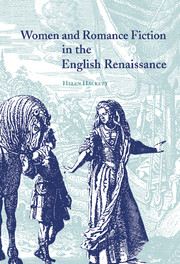Book contents
- Frontmatter
- Contents
- Acknowledgements
- List of abbreviations and a note on the text
- Introduction
- 1 The readership of Renaissance romance
- 2 Renaissance romance and modern romance
- 3 Novellas of the 1560s and 1570s
- 4 Spanish and Portuguese romances
- 5 Fictions addressed to women by Lyly, Rich and Greene
- 6 The ‘Arcadia’: readership and authorship
- 7 The ‘Arcadia’: heroines
- 8 ‘The Faerie Queene’
- 9 Shakespeare's romance sources
- 10 Lady Mary Wroth's ‘Urania’
- Epilogue: The later seventeenth century
- Notes
- Bibliography
- Index
6 - The ‘Arcadia’: readership and authorship
Published online by Cambridge University Press: 01 September 2009
- Frontmatter
- Contents
- Acknowledgements
- List of abbreviations and a note on the text
- Introduction
- 1 The readership of Renaissance romance
- 2 Renaissance romance and modern romance
- 3 Novellas of the 1560s and 1570s
- 4 Spanish and Portuguese romances
- 5 Fictions addressed to women by Lyly, Rich and Greene
- 6 The ‘Arcadia’: readership and authorship
- 7 The ‘Arcadia’: heroines
- 8 ‘The Faerie Queene’
- 9 Shakespeare's romance sources
- 10 Lady Mary Wroth's ‘Urania’
- Epilogue: The later seventeenth century
- Notes
- Bibliography
- Index
Summary
FEMALE READERS OF THE TWO ARCADIAS
The self-representations of 1570s and 1580s prose-fiction-writers as delinquents from duty are shared by the prefatory epistle to Sir Philip Sidney's Arcadia. This was first printed with the quarto New Arcadia in 1590 but composed to accompany the earlier manuscript version known as the Old Arcadia, written in 1577–80. It is one of the most striking examples of an Elizabethan fiction-author's self-construction as effeminised by his sojourn in the world of romance. In the first place, the epistle is addressed to Sidney's sister Mary Herbert, whose patronage is even more loudly proclaimed in the work's full title, The Countess of Pembroke's Arcadia. Most of the work was probably composed while Sidney was staying at the Countess's seat of Wilton, having incurred disfavour at court by criticising the Queen's proposed marriage to the Duke of Anjou; he was therefore himself enjoying a pastoral retreat from public duties just as were his heroes within the fiction itself. The very first sentence of the epistle declares the romance to be an ‘idle work’; later it is described as ‘but a trifle, and that triflingly handled’, fit only to be read by Mary at ‘idle times’. Just as Lyly Rich, Nashe and others associated idleness with the milieu of women, so does Sidney, but with less satire and more affection.
- Type
- Chapter
- Information
- Women and Romance Fiction in the English Renaissance , pp. 101 - 115Publisher: Cambridge University PressPrint publication year: 2000



